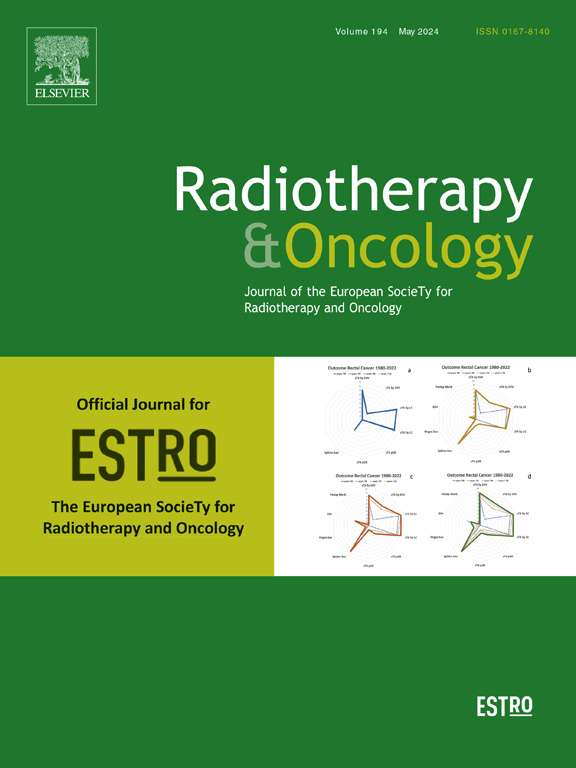系统回顾和荟萃分析定量,基于成像的方法预测肺癌患者辐射毒性的效用。
IF 4.9
1区 医学
Q1 ONCOLOGY
引用次数: 0
摘要
背景与目的:对放射组学、剂量组学和机器学习在胸部放射治疗毒性预测中的应用进行系统回顾和荟萃分析。材料和方法:进行电子数据库检索,并由独立作者进行双重筛选,以确定适合进行系统评价和荟萃分析的研究。提取数据并评估研究质量,机器学习研究使用TRIPOD,放射组学使用RQS,剂量组学使用RoB。结果:10703项研究被确定,5252项进入筛查。106项研究包括23,373例患者纳入系统评价。预测的主要毒性是放射性肺炎(81例),其次是食管炎(12例)和淋巴细胞减少(4例)。42项关于放射性肺炎的研究符合meta分析,合并曲线下面积(AUC)为0.82 (95% CI 0.79-0.85)。使用机器学习的研究表现最好,经典和深度学习模型也有类似的表现。随着出版年份的增加,模特的表现有提高的趋势。这三个研究类别的研究质量存在差异,剂量组研究在这些研究中得分最高。未观察到发表偏倚。结论:利用放射组学、剂量组学和机器学习的现有文献大多集中在放射性肺炎的预测上。未来的研究应侧重于其他危险器官的毒性预测,并将这些模型应用于临床实践。本文章由计算机程序翻译,如有差异,请以英文原文为准。
A systematic review and meta-analysis of the utility of quantitative, imaging-based approaches to predict radiation-induced toxicity in lung cancer patients
Background and Purpose
To conduct a systematic review and meta-analysis of the performance of radiomics, dosiomics and machine learning in generating toxicity prediction in thoracic radiotherapy.
Materials and Methods
An electronic database search was conducted and dual-screened by independent authors to identify eligible studies for systematic review and meta-analysis. Data was extracted and study quality was assessed using TRIPOD for machine learning studies, RQS for Radiomics and RoB for dosiomics.
Results
10,703 studies were identified, and 5,252 entered screening. 104 studies including 23,373 patients were eligible for systematic review. Primary toxicity predicted was radiation pneumonitis (81), followed by esophagitis (12) and lymphopenia (4). Fourty-two studies studying radiation pneumonitis were eligible for meta-analysis, with pooled area-under-curve (AUC) of 0.82 (95% CI 0.79–0.85). Studies with machine learning had the best performance, with classical and deep learning models having similar performance. There is a trend towards an improvement of the performance of models with the year of publication. There is variability in study quality among the three study categories and dosiomic studies scored the highest among these. Publication bias was not observed.
Conclusion
The majority of existing literature using radiomics, dosiomics and machine learning has focused on radiation pneumonitis prediction. Future research should focus on toxicity prediction of other organs at risk and the adoption of these models into clinical practice.
求助全文
通过发布文献求助,成功后即可免费获取论文全文。
去求助
来源期刊

Radiotherapy and Oncology
医学-核医学
CiteScore
10.30
自引率
10.50%
发文量
2445
审稿时长
45 days
期刊介绍:
Radiotherapy and Oncology publishes papers describing original research as well as review articles. It covers areas of interest relating to radiation oncology. This includes: clinical radiotherapy, combined modality treatment, translational studies, epidemiological outcomes, imaging, dosimetry, and radiation therapy planning, experimental work in radiobiology, chemobiology, hyperthermia and tumour biology, as well as data science in radiation oncology and physics aspects relevant to oncology.Papers on more general aspects of interest to the radiation oncologist including chemotherapy, surgery and immunology are also published.
 求助内容:
求助内容: 应助结果提醒方式:
应助结果提醒方式:


